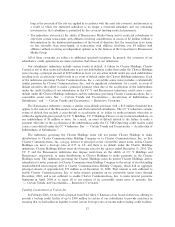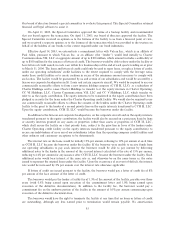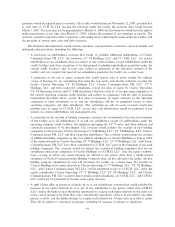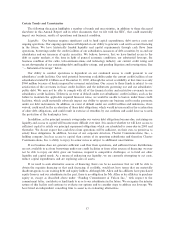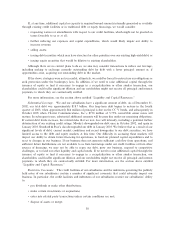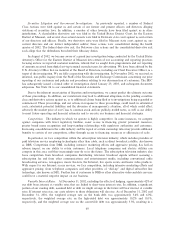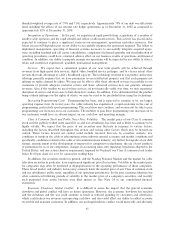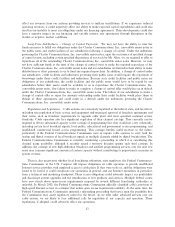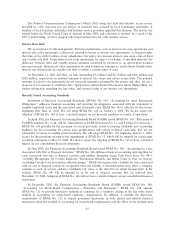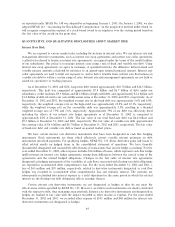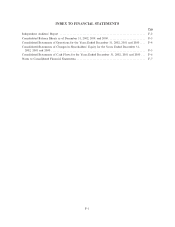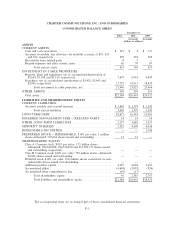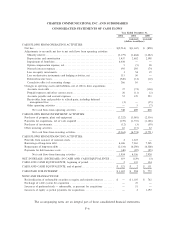Charter 2002 Annual Report Download - page 64
Download and view the complete annual report
Please find page 64 of the 2002 Charter annual report below. You can navigate through the pages in the report by either clicking on the pages listed below, or by using the keyword search tool below to find specific information within the annual report.aÅect our revenues from our systems providing services to military installations. If we experience reduced
operating revenues, it could negatively aÅect our ability to make expected capital expenditures and could also
result in our inability to meet our obligations under our Ñnancing agreements. These developments could also
have a negative impact on our Ñnancing and variable interest rate agreements through disruptions in the
market or negative market conditions.
Long-Term Indebtedness Ì Change of Control Payments. We may not have the ability to raise the
funds necessary to fulÑll our obligations under the Charter Communications, Inc. convertible senior notes or
the public notes and credit facilities of our subsidiaries following a change of control. Under the indentures
governing the Charter Communications, Inc. convertible senior notes, upon the occurrence of speciÑed change
of control events, including certain speciÑed dispositions of our stock by Mr. Allen, we are required to oÅer to
repurchase all of the outstanding Charter Communications, Inc. convertible senior notes. However, we may
not have suÇcient funds at the time of the change of control event to make the required repurchase of the
Charter Communications, Inc. convertible senior notes and our subsidiaries are limited in their ability to make
distributions or other payments to us to fund any required repurchase. In addition, a change of control under
our subsidiaries' credit facilities and indentures governing their public notes would require the repayment of
borrowings under those credit facilities and indentures. Because such credit facilities and public notes are
obligations of our subsidiaries, the credit facilities and the public notes would have to be repaid by our
subsidiaries before their assets could be available to us to repurchase the Charter Communications, Inc.
convertible senior notes. Our failure to make or complete a change of control oÅer would place us in default
under the Charter Communications, Inc. convertible senior notes. The failure of our subsidiaries to make a
change of control oÅer or repay the amounts outstanding under their credit facilities would place them in
default of these agreements and could result in a default under the indentures governing the Charter
Communications, Inc. convertible senior notes.
Regulation and Legislation. Cable systems are extensively regulated at the federal, state, and local level,
including rate regulation of basic service and equipment and municipal approval of franchise agreements and
their terms, such as franchise requirements to upgrade cable plant and meet speciÑed customer service
standards. Cable operators also face signiÑcant regulation of their channel carriage. They currently can be
required to devote substantial capacity to the carriage of programming that they would not carry voluntarily,
including certain local broadcast signals, local public, educational and government access programming, and
unaÇliated commercial leased access programming. This carriage burden could increase in the future,
particularly if the Federal Communications Commission were to require cable systems to carry both the
analog and digital versions of local broadcast signals or multiple channels added by digital broadcasters. The
Federal Communications Commission is currently conducting a proceeding in which it is considering this
channel usage possibility, although it recently issued a tentative decision against such dual carriage. In
addition, the carriage of new high-deÑnition broadcast and satellite programming services over the next few
years may consume signiÑcant amounts of system capacity without contributing to proportionate increases in
system revenue.
There is also uncertainty whether local franchising authorities, state regulators, the Federal Communica-
tions Commission, or the U.S. Congress will impose obligations on cable operators to provide unaÇliated
Internet service providers with regulated access to cable plant. If they were to do so, and the obligations were
found to be lawful, it could complicate our operations in general, and our Internet operations in particular,
from a technical and marketing standpoint. These access obligations could adversely impact our proÑtability
and discourage system upgrades and the introduction of new products and services. Multiple federal courts
have now struck down open-access requirements imposed by several diÅerent franchising authorities as
unlawful. In March 2002, the Federal Communications Commission oÇcially classiÑed cable's provision of
high-speed Internet service in a manner that makes open access requirements unlikely. At the same time, the
Federal Communications Commission initiated a rulemaking proceeding that leaves open the possibility that
the Commission may assert regulatory control in the future. As we oÅer other advanced services over our
cable system, we are likely to face additional calls for regulation of our capacity and operation. These
regulations, if adopted, could adversely aÅect our operations.
62


